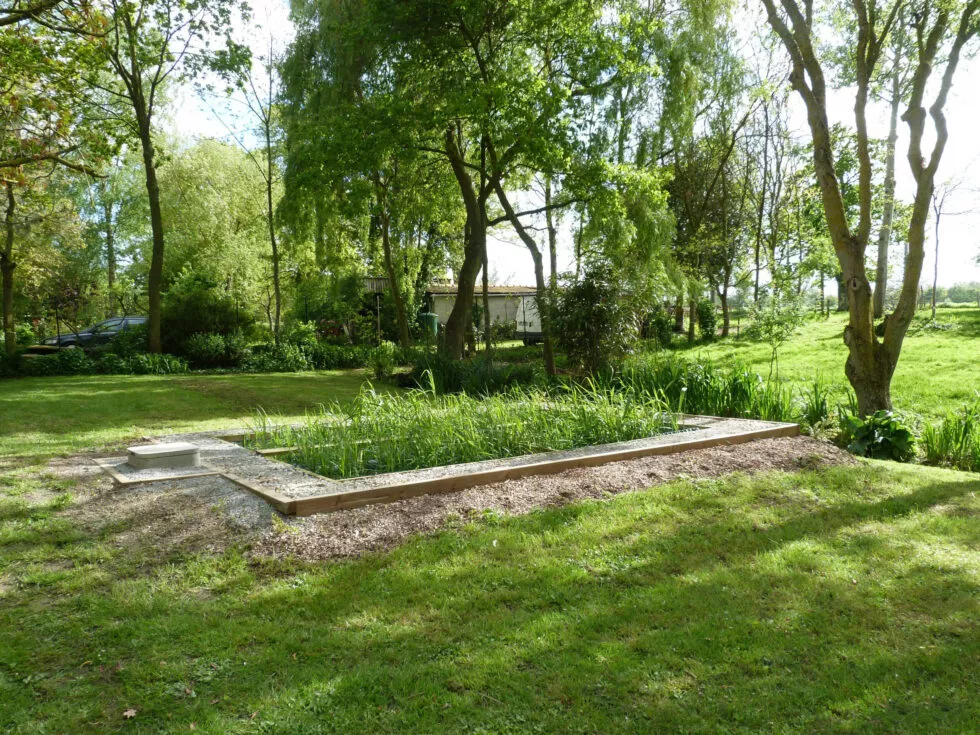Does phyto-purification take up space?

Phyto-purification is a method of wastewater treatment that uses plants to purify water naturally. Although it is often perceived as requiring a lot of space, this misconception can sometimes dissuade owners of modest-sized houses from considering this ecological solution. However, the space required for an effective installation is often less than you might think. Phyto-purification is a sustainable alternative to traditional wastewater treatment systems, while also enhancing the appearance of your garden.
Dimensioning an installation
For a typical house with five main rooms, the surface area required to install a phyto-purification system is generally between 10 and 20 square metres. This figure is relatively modest, especially when compared to other wastewater treatment systems, such as the sand filter. The latter requires about 25 square metres, in addition to a 3 cubic metre all-water septic tank. Phyto-purification can therefore be a viable solution even for medium-sized outdoor spaces.
Population equivalent (PE): a key indicator
Definition
Population equivalent (PE) is a unit of measurement used in the field of sanitation. It is used to size purification systems by estimating the average pollution load produced by one person.
Usefulness in individual sanitation
In the context of individual sanitation, the population equivalent is essential for determining the optimal size of wastewater treatment systems. An accurate estimate of the PE avoids the oversizing or undersizing of the installation. An accurate estimate of the PE ensures the efficiency and sustainability of the installation, while optimising costs. In concrete terms, one PE corresponds to the organic load produced daily by one person. This measurement takes into account domestic wastewater, including water from the kitchen, toilet and laundry, as well as dissolved or suspended organic matter.
Methodology for calculating the population equivalent
The calculation of the population equivalent is based on several key factors:
- Water consumption: domestic water consumption is an indicator of the quantity of wastewater produced by a household. It includes water used for cooking, washing, bathing and other household uses. On average, a person consumes between 100 and 200 litres of water per day, depending on their lifestyle and the equipment used (such as low or high consumption electrical household appliances).
- Waste production: organic waste, such as food scraps and human waste, contributes to the pollution load of wastewater. The quantity of organic matter produced per person directly influences the need for treatment in the sanitation systems. This waste is measured in terms of Biochemical Oxygen Demand (BOD5) which indicates the quantity of oxygen necessary to break down the organic matter present in the water.
- Wastewater characteristics: the chemical and physical characteristics of wastewater, such as nutrient concentration (phosphorus, nitrogen), suspended solids and household chemicals, are also taken into account. These parameters influence the choice of treatment technologies and the capacity of sanitation systems to guarantee discharges that comply with environmental standards.
Soil studies: an essential prerequisite
Installing a phyto-purification system is not just a matter of choosing a spot in the garden. It is important to carry out a preliminary soil study. This stage, often carried out by a sanitation design office (or Aquatiris), ensures that the soil is suitable for this type of system. A thorough soil study can also help determine the most efficient and aesthetic configuration for your garden. It ensures that the system will function optimally, integrating harmoniously into the existing environment.
Aesthetic and ecological advantages of phyto-purification
In addition to its environmental benefits, phyto-purification also offers significant aesthetic advantages. By using plants such as reeds, cattails or certain grasses, it not only helps to purify the water, but also to embellish the garden. These plants play a role in the wastewater purification process. Their presence adds a decorative touch, bringing a natural and harmonious aesthetic to the outdoor space.
Phyto-purification, a sustainable investment
The installation of a phyto-purification system represents a long-term investment that can offer substantial savings on sanitation costs. Unlike conventional systems, phyto-purification requires less maintenance and does not involve the use of chemicals. In addition, it uses natural resources efficiently and contributes to reducing the ecological footprint of your home.
Conclusion
In conclusion, although phyto-purification requires 2 to 4m2 per population equivalent, it represents an ecological, aesthetic and relatively unconstraining solution for the treatment of wastewater. With an appropriate soil study, it can be optimally integrated even in medium-sized gardens. This method, in addition to contributing to the preservation of the environment, embellishes your outdoor space by adding a natural and lively dimension.

